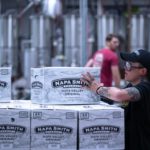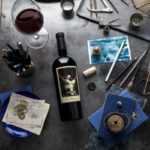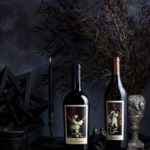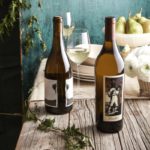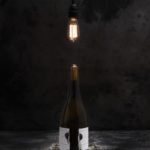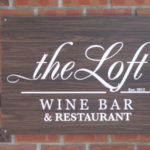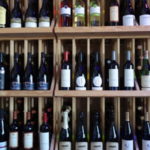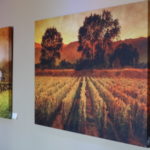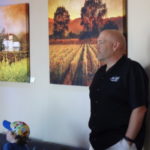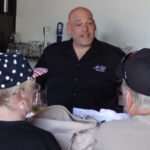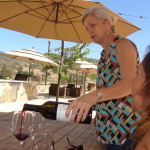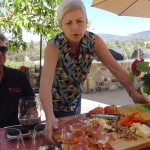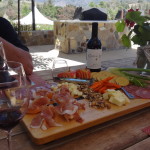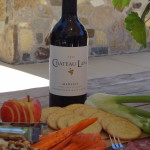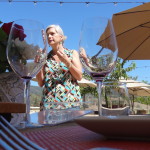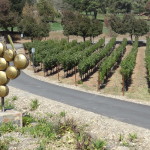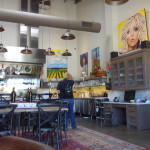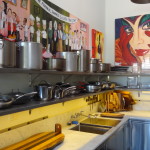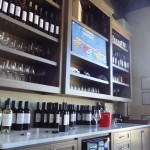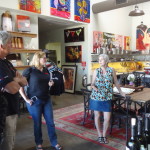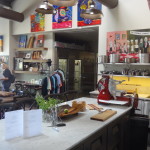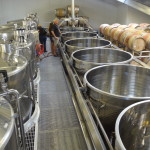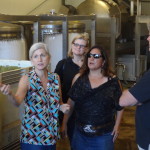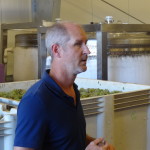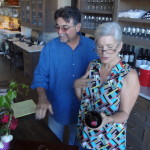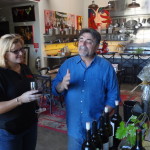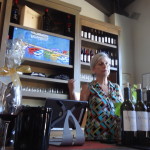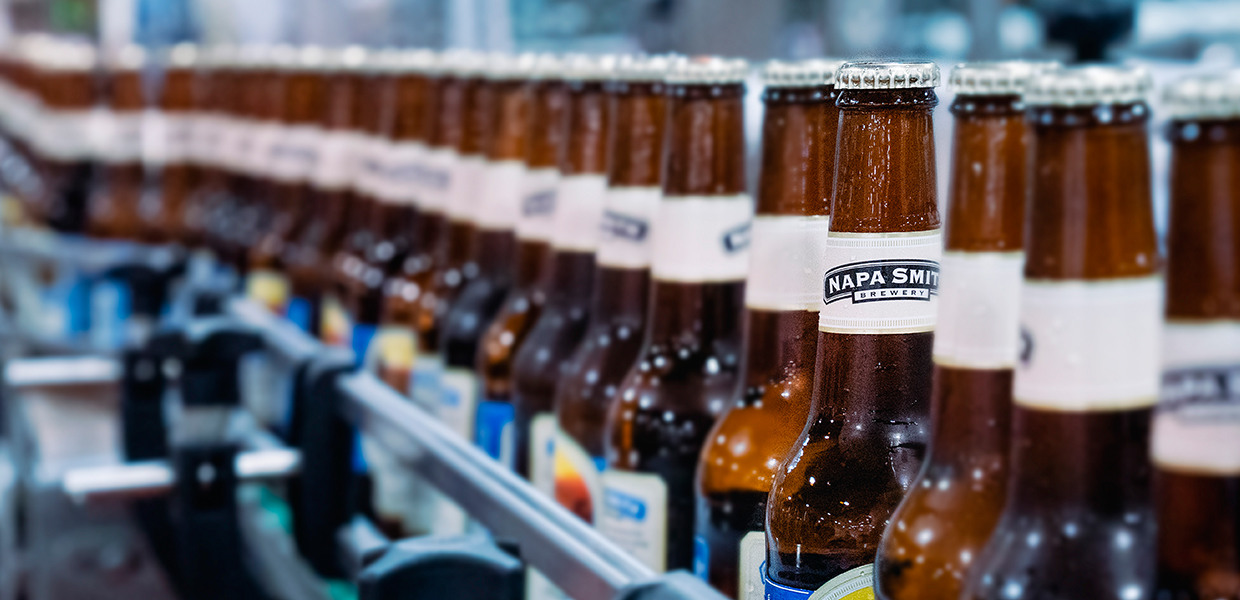
Moving to the wet mile
By Nate Gartrell
In late 2016, the well-known Napa Smith Brewery made a decision many found surprising: moving out of the Napa Valley and setting up shop 15 miles south, in Vallejo. In May 2017, its owners opened a new taproom off of Sonoma Boulevard. It may seem odd for a brewery with “Napa” in its name to resituate from a world-famous fermentation enclave to a city that—until recently—didn’t even have a single brewery (it now has several), but the folks at Napa Smith say the move has paid dividends.
“What has been so welcoming and perfect for our brewery is the foot traffic off of Highway 29,” said Napa Smith’s Hospitality Manager Noelle Roldan. “Before, we were off the beaten path and it was hard to find us, and there wasn’t much food around. But now, right up the road, you have Bud’s Burgers, Pho #1, Mountain Mike’s, CJ’s BBQ, just all this stuff all around us.
“Ever since moving to Vallejo we’ve seen way more foot traffic, and way more local traffic,” she continued. “You have the freeways, you have the hotels, and just being in this location, in general, has been a huge step for us.”
The brewery was founded in 2008, but in the last five years has undergone changes and an expansion that brought it to Solano County. It is built on the legacy of Don Barkley, a master brewer with more than 40 years experience in the business.
“He’s considered a grandfather of craft brewing,” Noelle said.
But in 2013, Napa Smith was bought by Robert S. Lipman, the owner of Lipman Brothers Inc., a Tennessee-based company that produces wine, spirits, beer and non-alcoholic beverages across the country.
“He is an advocate of all kind of spirits in general, he owns a winery, he owns spirits, he owns breweries and he was enthusiastic about Napa Smith brewery just because of the brand itself and what we do in terms of beer,” Noelle said of Lipman. “He took the [Napa Smith] brand to a whole new level.”
Three years after Lipman Brothers took over, Napa Smith announced it was expanding, more than doubling its production as part of the move to Vallejo. In a news release, Napa Smith owners said the move made them the smallest independent bicoastal brewery in North America at the time, producing around 11,000 barrels of beer annually.
The last few years at Napa Smith have also seen the rise of Stein Servick, a protégé of Barkley who’s pathway to beer making led off the beaten trail. Servick has a science background—a genetic physicist by trade—but something (maybe the fact that his first name is also the word for a traditional beer mug) just couldn’t keep him away from the brew game. Noelle said he learned the trade “slowly but surely by working at different breweries” to become a master brewer, before taking the helm at Napa Smith.
“His science background has helped the brewery in many ways,” Noelle said. “Specifically, in keeping a consistent and quality product on the shelf at all times.”
Napa Smith is best known for two things: quality and variety. In the age of craft brewing, the latter is especially important; some folks are diehard IPA fans and won’t touch a pilsner with a 10-foot pole, while others prefer a more mild taste and hate “bitter beer.” It’s the kind of business where customers know what they like and what they don’t, and expect the product to speak for itself. With so many fish in the sea, it can be tough for breweries to separate themselves from the pack.
“We carry 14 beers on tap at any given time,” Noelle said. “We really pride ourselves in being a brewery where everyone can come and find a style they enjoy. That’s why we make so many beers, to capture the broad audience of beer.”
Napa Smith’s taproom doesn’t have a kitchen, but they’ve made up for that by inviting local food trucks to plant themselves right outside, giving folks easy access to a hot food break in between beers. They also organize “beer dinners” that include partnerships with other restaurants and businesses. On December 15, for instance, Napa Smith is putting on a fundraiser benefiting the Jesse Bethel High School’s band program. It will feature CRSB, a homegrown musical duo that bills itself as “island-infused R&B pop” with three #1 hits on Hawaiian radio waves.
“It’s going to be a really fun event for the community,” Noelle said.
Earlier this Fall, Napa Smith teamed up with Chardonnay Golf Club in American Canyon to hold a three-course meal that featured three different beers on tap. Brewers also attend these events, which adds an “informative tour” angle to them, Noelle said.
Noelle added that the folks at Napa Smith hope to make this an annual tradition and organize other collaborative events with other local businesses, maybe even before the year is up.
“We donate to every chamber event, we try to help out with community donations as much as possible. When people come to us it’s usually a ‘yes,’” Noelle said. “We’re excited to be here in Vallejo. Nothing but good things, nothing but great customers, just slowly but surely growing the brand and making Vallejo home.”
“We are dog-friendly and kid-friendly,” she continued. “The community has been warm and inviting, especially all the leaders within the community. Everyone has been good to us, we just want to be good back to them.”
Napa Smith Brewery’s Vallejo taproom is located at 101 Yolano Drive in Vallejo. It is open seven days a week from noon to 10 p.m. For additional information, call (707) 252-4392, or visit www.napasmithbrewery.com.
And true to their roots, Napa Smith beers are still available on tap in Napa at The Village Napa Valley – Vista Collina Resort & Spa, at 850 Bordeaux Way. It is the only brewery featured at the spa, with 10 beers on tap at any given time.

Nate Gartrell grew up in Benicia, studied journalism in college, and has written for a handful of media outlets since age 15. He aspires to visit all 30 Major League Baseball stadiums and to hit the trifecta at the horse track.
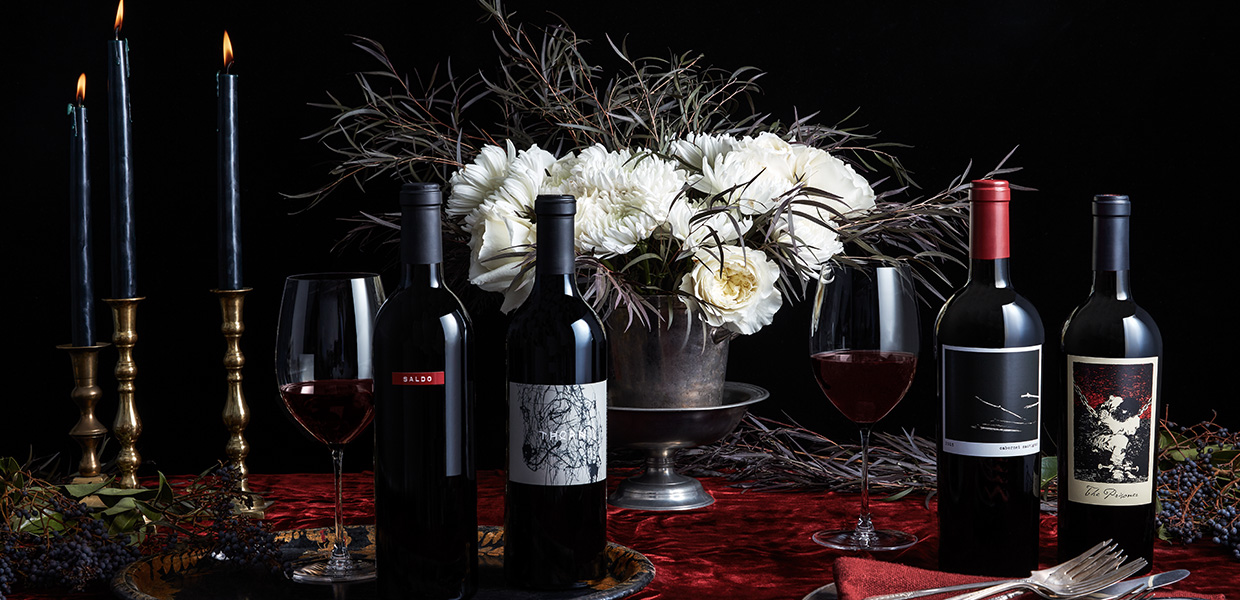
The Prisoner Wine Company provides a tasting experience that challenges tradition
By Matt Larson
Tourists come from far and wide to Napa Valley with the sole objective of experiencing as many different wines as they can get their senses on. Hundreds upon hundreds of Napa’s wineries are actively serving up these guests every single day, and the region is world famous for satisfying any wine connoisseur (… wineoisseur?). Napa is home to some of the best winemakers the world has ever seen, and amidst this immense competition comes The Prisoner Wine Company, an established wine organization that, after a nomadic 20 years, will be finally opening its own doors for the very first time, possibly, as soon as you’re reading this article. So what sets it apart?
“The Prisoner Wine Company is about defying expectations in every way—from the blend of grapes to the artwork on the label to what a tasting room should look like and what the guest experience should be like,” Property Director Brigid Harris said. “It’s the details that make The Prisoner Wine Company one-of-a-kind.”
Prisoner is no stranger to wine enthusiasts nationwide; in fact, they’ve been developing a fiercely loyal following throughout the past 20 years at occasional pop-up events all around the country. The Prisoner Wine Company now has a brick-and-mortar home of their own; and of all the regions in Napa Valley to choose from, greater St. Helena is now their home. “Fans have had no way to experience this brand in person, in the place where the wines are made—the new property provides this,” Harris said. “We are very excited to be able to welcome longtime supporters and new fans!”
Inspired by the “mixed blacks” made by the very Italian immigrants who originally settled in Napa Valley during the early 1800s, Prisoner has some of the boldest, most intriguing wines you’ve ever laid your taste buds on. Their signature blend, The Prisoner, was first produced by founder Dave Phinney, and it was quickly recognized by consumers and critics alike as one of the most innovative Napa Valley wines on the market, leading the resurgence of California red blends and earning cult wine status. So start with The Prisoner, then let your conscience be your guide. They blend classic and unexpected varieties from California’s best wine regions to make wines that are approachable, yet thought-provoking. They also incorporate their own grapes, grown onsite.
Today, their director of winemaking is Chrissy Wittmann. With a background in Ecology and Systematic Biology at Cal Poly, San Luis Obispo, she found her love for wine while analyzing soil. She worked as a laboratory enologist and later achieved her master’s degree in Agriculture. With more than a decade of professional experience in the business, her expertise in vineyard partnerships comes in to play on a daily basis.
“Chrissy and her team collaborate with over 100 grape growers, visiting each vineyard site throughout the year to carefully assess the style and quality of each lot to make the best possible wine from each vintage,” Harris explained. “The majority of our grower partners are ‘mom & pop’ producers who have worked their land for generations. In many ways, our work with these growers contributes to the preservation of California winemaking history—we’re looking for vineyards of character and tradition, not just commercial viability.”
Following commercial norms is really the antithesis to what Prisoner is all about, as you’ll see when you visit them they are all about personality. “The design and décor of the building is unlike anything seen in wine country before,” Harris said. “We worked with renowned San Francisco architect Matt Hollis and Napa-based interior designer Richard Von Saal to create the aesthetic of the property, which reflects the out-of-the-box approach that the wine labels take.” Not to mention their unique wines themselves. As their mantra states, upon arrival: Expect the unexpected.
If you’re not one for spoilers, maybe you should skip this paragraph, but one of those very unexpected things you’ll encounter when visiting The Prisoner Wine Company is The Makery. It began in 2016 as The Makery Experience, a series of pop-up gatherings in cultural communities across the country. Now as part of Prisoner, The Makery celebrates artisans, designers, and creators who share the same raw spirit of innovation and craftsmanship that you’ll find in their wines. At The Makery, you’ll encounter an ongoing carousel of makers from varied fields to ensure that every visit is perfectly unique.
The Makery is a private tasting space comprised of four studios, with each studio containing one of Prisoner’s featured Makers. These Makers will collaborate with The Prisoner Wine Company and, inspired by the wines, will be creating unique items only available at the winery. As a guest you can choose from two private experiences: The Journey and The Makery. Each will elevate traditional wine and food pairings via the discovery of the makers’ art.
Prisoner’s first makers in residence will be Sabrina and Emma Mann of Soap Cauldron in Sonoma. Home of the Three Sisters Apothecary’s line of artisan soaps and skincare, they are also the creators of Soapy Tails, an all-natural canine bath and coat care line. You can also meet with Chef Joshua Felciano of Bayview Pasta in San Francisco and learn about his passion for producing hand-milled flour; coupled with his direct-to-farm sourced grain he crafts pasta, pizza, and breads. They’ve also announced Mercedes Stahlberger of Wine Lover’s Jelly, potter and former Hollywood fashion designer Amanda Wright … suffice it to say, a visit to The Prisoner Wine Company will involve much more than tasting wine, though wine will play a role in your visit every step of the way.
“We are thrilled to offer wine tastings elevated by food prepared by Winery Chef Brett Young, ranging from small bites to extensive and innovative wine and food experiences,” Harris said. Young enrolled at the Culinary Institute of America (CIA) in Hyde Park, New York City, and his studies there included an externship at the Ritz-Carlton Millennia in Singapore which shaped his thinking about all things food, wine and hospitality. He later went to Las Vegas to work as Master Cook at Alain Ducasse’s Mix at Mandalay Bay, and joined COPIA in 2008 … his list of culinary accomplishments goes on, but look forward to his fresh and seasonal dishes tailored to complement the wines you’ll be tasting at Prisoner.
A unique wine company warrants a unique name, and “Prisoner” was the perfect fit. Founder Dave Phinney was looking to create a label for his award-winning wine and named it The Prisoner, inspired from an etching by Spanish artist Francisco Jose de Goya titled: La Petite Prisonier. The piece was given to Phinney by his parents when he was just 12 years old. Goya is often referred to as both the last of the Old Masters and the first of the moderns, transcending generations and innovating the concept of style—quite similar to how The Prisoner Wine Company is changing the tasting game in Napa.
On the winery’s website you can get to know many of the growers who contribute to Prisoner’s wines. While their family of growers has evolved over the years, they’re proud to say they still work with most of the growers hand-picked by Phinney, growers who contributed to the first wines he ever made. “We continue to seek out top-tier fruit from new producers to welcome into our family,” Harris said. “In buying unexpected, less-typical grapes (from Napa Valley and Sonoma County) like Charbono and Viognier, we have helped provide a kind of ‘second life’ to these producers who may not otherwise be able to continue to grow these rare and exceptional grapes.”
The Prisoner Wine Company is happy to make any customizations necessary for each guest. An average visit can cost anywhere from $45-300 per person, depending on what you’re looking for. They are located at 1178 Galleron Road on Highway 29, just south of St. Helena. For additional information, call them at (866) 255-7401 or visit theprisonerwinecompany.com. They are just now releasing their first ever sparkling wine and Pinot Noir, so schedule your visit as soon as you can! Come in for a drop-in wine tasting or a special by-appointment experience, but let it be known that reservations are highly recommended, as the moment they open their doors, The Prisoner Wine Company will be in high demand.
Chef Sample Dishes & Pairings
Vegetables/Fruit
Stone Fruit Salad
Goat Cheese Fondue, Hazelnut Dukkah, Lemon Verbena Vinaigrette
ERASED (sparkling – Blanc de Blanc)
Grilled Brentwood Corn
White Miso, Pickled Lime, Thai basil
No. 39007 (Chenin Blanc)
Meat
Grilled Lamb Shoulder
Farro Piccolo, Fermented Mustard Greens, Ras El Hanout-Orange Vinaigrette
Thorn
Jamaican Jerk Quail
Roasted Sweet Potato, Mizuna, Pickled Kumquat
Blindfold
Fish
Applewood Smoked Black Cod
Summer Succotash, Tomatillo, Lemon Balm
The Snitch
King Salmon
Sake Kasu, Summer Squash, Tomato-Dashi
The Prisoner
Pasta
Garlic Scape Bucatini
English Pea, Morrel Mushroom, Pecorino Romano
Syndrome (Rose)
Fromage Blanc Agnolotti
Corn Pudding, Tomato Confit, Fermented Summer Truffle Vinaigrette
Headlock (Charbono)
Spice
Za’atar—Citrusy, smoky, herbal. It is used on gluten-free crackers with smoked eggplant dip.
South African Spice, Ras El Hanout—floral, complex blend of spices used in Northern Africa cuisine similar to a curry. Used in vinaigrettes and dry rubs with lamb
- FREEZE DRY—Name a few items you are excited about freezing with your new fancy machine—what’s it called again? This machine gives dishes another texture. Instead of heating foods, it freeze dries them at negative 50 degrees Fahrenheit. You get a crunchy texture versus a leathery texture (like dried fruit).
 Matt Larson is an actor/comedian/director from Vallejo who lives a double life between the Bay and LA. When he’s not writing for Local Happenings Magazine he could be editing a short film or working on his next rap album—who knows!
Matt Larson is an actor/comedian/director from Vallejo who lives a double life between the Bay and LA. When he’s not writing for Local Happenings Magazine he could be editing a short film or working on his next rap album—who knows!
Keep up with all things Larson at: www.MarsLegstrong.com.

When Frank Kennedy first spoke of opening a winery on Vallejo’s Mare Island, people told him he was nuts. Mainly accessible by drawbridge, the area was better known as a defunct US Navy base, rather than the hotspot for new homes and businesses as it’s known today. Plus, many wondered how a wine tasting room could compete with the nearby Napa Valley, an internationally known attraction for wine lovers.
That was roughly 18 months ago. Now, more than 10,000 customers later, Kennedy and his business partner, Twila Nixon, seem like trailblazers. Their winery and Mare Island tasting room, known as Vino Godfather, was set up in October of 2015. Though their last names might suggest they’d get along about as well as a couple cats in a bag, Nixon and Kennedy have worked together to build Vino Godfather into a local favorite. Their efforts haven’t gone unnoticed. In fact, there are whispers that several wineries––as well as a distillery––are looking to follow suit and set up tasting rooms on the island.
“I’d love to see a whole winery row here, where people can go from winery to winery,” Nixon said.
The success of Vino Godfather––as well as the nearby Mare Island Brewing Company––may have opened the door for the possibility of a wine and restaurant boom on the island, but not just sellers of intoxicating beverages are setting up shop there. For years, Vallejo relied on the Navy base as its lifeblood, and the local economy struggled to recuperate after the base closed its doors. However, Mare Island––which now has Touro University, an athletic center, a prefab home business, and much more––seems to be testing new waters. The last three years have seen an increasing number of new business applications on the island, and the Solano County Department of Transportation has talked about expanding freight service there as well.
“There is a revival going on here,” Kennedy said. “It’s fun to be a part of it. We bring people in from all over the place, not just Solano County.”
Before Kennedy was known for Vino Godfather, he was known for the wine it now provides––released four years before Vino Godfather’s opening––called Prohibition Wines. The name is a tribute to Kennedy’s ancestors, whom he said, “did a little bit of bootlegging” during the Prohibition Era. Kennedy, following in his family’s footsteps, spent 20 years working in the business. He started working on Prohibition Wines in 2008, years before the first batch was released.
Now, Kennedy and Nixon have teamed up with longtime Bay Area winemaker Warren Smith, who heads production at Vino Godfather. The winery is planning to fill thousands of bottles this year, and it recently signed a contract for distribution with Costco. Kennedy said he thinks their success is dependent on their ability to consistently produce high quality wine.
“We want to put the best wines we can in the bottle,” Kennedy said. “We use real corks so you can get bottle aging—we don’t skimp on anything.”
It took months for Nixon and Kennedy to build Vino Godfather’s tasting room, which is located at the former home of a US Navy commander. The building is one of several historical mansions on the island. Trees surround it, and Roman-style pillars hold up the porch. Visit the tasting room, and you might hear some Frank Sinatra, or notice plaques commemorating the Godfather film series as you order your wine. The porch is furnished with fluffy couches, and folks are encouraged to come by with takeout food, sit on the porch, and enjoy a glass of wine and the summer breeze.
“It’s beautiful out here, and you’re totally protected,” Nixon said, while sitting on the porch during a sunny afternoon in early March. “People will come out here when it rains and watch the rain for hours.”
They also do what they can to preserve Vallejo’s history: the walls are covered with pictures of old navy boats, including one that transported an atomic bomb during World War II. Behind each picture, there is a story where Vallejo history and US history intersect. Like what has happened with the Mare Island Brewing Company, customers at Vino Godfather occasionally offer to bring in their historical artifacts or photos for display.
“One of our clients is a navy historian, and actually grew up in one of the homes around here,” Kennedy said. “We became good friends with him and when we told him we’d love to turn this room into a historical room, he gave us all these pictures. They’re wonderful.”
Vino Godfather’s wines are priced around $20-25 a bottle. Nixon and Kennedy have recently started a wine club as well. The club offers a discount of three purchases a year––typically coming out to around a case of wine, according to Kennedy.
“We’re priced right, we’re not pricing ourselves out of the market,” Kennedy said. “We aren’t catering to people who pay $100. We want people to be able to drink our wines all the time, not just on special occasions.”
Vino Godfather has year-round events, and they kick it up a notch during spring and summer. On Saturdays, the winery hosts live music events on an outdoor stage, adjacent to the island tasting room. They offer two glasses of wine, and food that is provided by a local cafe for a $15 entrance fee.
Vino Godfather’s tasting room is located at 500 Walnut Avenue on Mare Island (the closest cross street is Kansas Street), across from the VA Clinic at the first mansion on Mansion Row. Its hours are 2 p.m. to 6 p.m. on Tuesdays and Wednesdays, noon to 8 p.m. on Thursdays and Fridays, noon to 6 p.m. on Saturdays and Sundays. On Saturdays, they also have live entertainment, and pizza that’s cooked in a brick oven outside. For more information, call (707) 552-2331 or visit them on the web at: www.vinogodfather.com.

Nate Gartrell grew up in Benicia, studied journalism in college, and has written for a handful of media outlets since age 15. He aspires to visit all 30 Major League Baseball stadiums and to hit the trifecta at the horse track.

In the wine industry, it’s common to hear titles like “wine steward” or “wine connoisseur.” But Benicia native Jason Diavatis, the owner of a popular Benicia wine bar known as The Loft Wine Bar & Restaurant, has a slightly different take.
“I’m comfortable with the title ‘Wine Idiot,’ Diavatis said. “People ask me all the time if I’m a sommelier, and I say, ‘No, I’m a wine idiot.’ Sommeliers have to take classes and tests and all kinds of stuff. Me? I just drink. I’m an expert at consumption.”
“Wine idiot” is sort of an odd title for someone to self-apply, especially Diavatis, who calculates profit percentages in his head, spends countless hours meticulously selecting the Loft’s wines, and who has come this far along after entering the wine business just four years ago. But he wears the title to show that he doesn’t take himself too seriously, and to help make potential wine newbies feel at ease about coming in and asking questions.
“Wine can be so pretentious and intimidating. I tell people all the time, ‘It’s just fermented grape juice,’” Diavatis said. “I don’t care if you’ve been drinking wine for 50 years or this is your first glass. I just want you to be able to come in here and enjoy it … I don’t want you to feel like you have to know everything about it to enjoy it.”
Diavatis has a lighthearted, sportive personality. In an hour-long interview with Local Happenings, Diavatis stopped himself mid-sentence frequently to say hello to passers-by he recognized, or resume a friendly banter with a repeat customer. He also managed to sneak in colorful jokes whenever possible, and can squeeze a laugh out of almost any situation. But the more you learn about its operation, it’s clear he’s obsessed with the details. An event planner by trade, he knows exactly how he wants his business to be run. He’ll tell you if his tables are set up two inches too far to the left, or if you’re using the wrong type of outdoor color combinations in the lighting of a particular event. He’s constantly looking at customer feedback, to see if there’s any room for improvement.
But above all else, Diavatis sees giving a platform to hidden gems in the wine world as a matter of pride. He takes great pains to find good wines that aren’t well known to the market, a painstaking task that gets harder with time.
“These days I probably taste roughly around 3,000 wines a year. On average, about 5 percent of the wines I taste, I like,” Diavatis said. “The first thing I look at is exposure. If it’s at Safeway, Costco, Raley’s, BevMo, Trader Joe’s, or any other restaurant or store in this area, I’m not interested.”
He sticks to this principle even when it’s hard. When a wine becomes too popular, he stops offering it and scours the market for a replacement. Because of that, the Loft’s selection is constantly changing.
Other than that, he uses this basic criteria: “I find wines that I enjoy and that I want to share with people.” Of course, the price also has to be right.
“I need to not only have a profit margin, but it also has to be good value and fair to my guests,” Diavatis said. He then added, with a sigh, “I’ve had lots of wines come in where the math was out of balance; they want to charge too much, and it just wouldn’t be fair to the customer.”
The Loft opened in 2012, and about three weeks before this issue of Local Happenings was published, Diavatis celebrated its 4th birthday. At first, it was just a place to get wine and not much else. A year later, Diavatis signaled that he was ready to expand operations, hiring his first chef and opening a small kitchen space. In December 2015, they took it a step further, opening a larger kitchen and offering a spectrum of hot meals and desserts.
“I get really good feedback from my customers, they’re important and I listen to them,” Diavatis said. “And they were telling me, ‘Hey we’re hungry.’”
Diavatis decided to bring the same concept to the kitchen that he uses to select his wine. “It has to be eclectic,” he said.
One of the Loft’s most popular specials is the beef wellington, an old British dish that you can’t find on too many menus these days. “It’s really difficult and time consuming to prepare, which is why we do it here,” Diavatis said. “I want things that are special and unique to us.”
The Loft’s cheeseburgers are topped with mac and cheese, and their appetizers include a (literally) flaming Greek cheese. Dessert selections include s’mores and banana splits. If you bring your kids, Diavatis might whip up a special (non-alcoholic) drink for them.
Diavatis, a Benicia native, is also trying to do what he can to make Mondays in Benicia a bit more interesting. There are a lot of Mondays, even during the summer, where you can walk down First Street at 9 or 10 p.m. and hear a pin drop (though not so much since the invention of Pokemon Go!). Diavatis has noticed this too, and that’s why he makes sure to keep the The Loft open around the clock.
“It’s always been frustrating when you want to go out in Benicia and you’re like, ‘Oh wait, it’s Monday,’” Diavatis said. “So we’re open seven days a week. There are days when there’s nothing going on downtown and it’s tempting to say, ‘we’re not going to open this Monday.’ But for me, growing up in this town, I always wished more places would be open, so that’s how we handle it.”
The Loft serves wine by the glass, and glasses start at around $9. If you’re not sure what you like, don’t be shy about asking the self-described “Wine Idiot” for advice.
The Loft Wine Bar & Restaurant is located at 280 1st Street in Benicia. It is open from 4 p.m. to 9 p.m. Monday thru Thursday, 4 p.m. to midnight on Friday, 11 a.m. to midnight on Saturday, and 11 a.m. to 8 p.m. on Sunday. For more information, call 707-745-4200, or like The Loft’s Facebook page, which includes menus and daily updates, at www.facebook.com/theloftwinebar.

Nate Gartrell grew up in Benicia, studied journalism in college, and has written for a handful of media outlets since age 15. He aspires to visit all 30 Major League Baseball stadiums and to hit the trifecta at the horse track.

As the great American writer Jack London detailed in his memoir John Barleycorn, Vallejo and Benicia have a rich drinking history. The way London describes it, a sizable amount of real estate in this area was dedicated to producing alcohol. But somewhere down the line, Vallejo fell off track a little. Despite the city’s close proximity to Wine Country, there wasn’t much in the way of breweries or wineries in town, until recently.
The tide started to change in 2014, when Mare Island Brewing Co. opened at the Vallejo Ferry Building, which is ironically located a short distance away from where London was rescued by a Greek fisherman more than a century ago, following an evening when London got a bit too inebriated.
Mare Island Brewing Co.’s co-founders (and co-brewers) Ryan Gibbons and Kent Fortner are a pair of winemakers turned brewers. Gibbons was the first to decide to go from “grape to grain,” leaving the wine industry to begin his tenure at Lagunitas before finally going into business with Fortner.
Fortner, in addition to being a longtime fermenter, is a history aficionado who settled on Mare Island and has taken the time to learn the stories of past generations. As a tip of the cap to their brewery’s home base, he and Gibbons have named their beers after elements of the island’s history.
“We’re able to use the history and pay homage to it, and continue that history on,” Gibbons said. “One of the things I’ve noticed is that there’s a huge gap between those who lived and worked on Mare Island and those of us who are younger, who might see it as just a bunch of abandoned buildings, or might not know what it is. We’re trying to bridge the gap with beer.”
Their first release, Saginaw, is named after the first wooden ship to be christened in Mare Island. The name of their second release, Coal Shed Ale, was chosen simply because they brew in old Mare Island coal sheds, and because they plan to incorporate work from artists inhabiting other coal shed studio space into the taproom layout. They’ve also come up with a trademark beer to the Vallejo Admirals baseball team.
“Because we come from a winemaking background, balance is important to us,” Fortner said in 2014. “We do have some hoppy beers, but in general, our beers are a little more toned down, a little on the balanced side.”
When they opened in 2014, Fortner and Gibbons expressed hope that their opening would inspire other breweries and wineries to set up shop in town.
“We’d like for this to be a brewing town,” Gibbons said. “With the look of Mare Island and its industrial grit, it’s such a nice area to just sit down and enjoy a pint on the waterfront.”
And according to Frank Kennedy, of Vino Godfather winery, that’s exactly what happened. Kennedy, along with his partner Twila Nixon, opened the Vino Godfather tasting room in October 2015, in an historical mansion on Mare Island.
“I’ve always liked Vallejo and thought that it had a lot of untapped potential for doing a tasting room,” Kennedy said. “I had seen the success Mare Island Brewery had by opening the tasting room at the ferry building, so we wanted to be the first ones out here on Mare Island to open a wine tasting room.”
Kennedy, a 20-year veteran in the wine business, has been working on Vino Godfather wines since 2008. He and Nixon first released a batch of their signature brand— Prohibition Wines — in 2011. Kennedy said the title is a tip of the cap to previous generations in his family, who were also longtime winemakers.
“My grandpa and uncle grew grapes during [the Prohibition] era, and they basically did a little bootlegging on the side to survive back in those days,” Kennedy said. “It’s kind of a reference to that era.”
Kennedy and Nixon retained longtime Bay Area winemaker Warren Smith to head production and collaborate with Kennedy. Since opening last October, they’ve attracted roughly 7,000 customers to their tasting room, Kennedy said.
“We try to make our wines really balanced and fruit-forward, and what appeals to about 80 percent of the mass,” Kennedy said. “Our wines are unique in style.”
Kennedy and Nixon’s success has piqued the interest of other wineries in the area, and Kennedy says he expects more to set up shop on the island.
“I believe Vallejo is the new frontier for wineries and breweries,” he said.
It may also become the new frontier for distilleries.
Earlier this year, it was announced that the Splinter Group plans to open a distillery and taste room on Mare Island as well. It is expected to open at the end of 2016, after Splinter Group began talks with Lennar Mare Island, the property management company in charge of the Mare Island, to lease the historic Building 45 last year.
“Lennar Mare Island is very excited about Splinter Group coming to Mare Island. Building 45 is a special piece of Mare Island and we have been seeking a business who appreciates its history, understands its future, and can attract visitors,” Lennar spokesman Edward Moser said.
Splinter Group focuses on whiskey distillation, and currently offers two lines: an 84-proof bourbon whiskey called Straight Edge, and an American whiskey called Slaughter House. The latter is aged in American Oak for nine years and is advertised as having a taste of caramelized sugar, baking spices, dark fruits, butterscotch, and vanilla notes. Last year, Slaughter House took a gold medal and “best in class” at the 2015 Whiskies of the World Competition. The distillery is currently housed in Napa, but its owners are excited about spreading out into Vallejo, Moser said.
“They were enthusiastic about the opportunity to open their business within Mare Island’s historic core,” said Moser. “We are happy to have business opportunities like this that continue to bring visitors and economic activity to the city of Vallejo and Mare Island’s historic core.”
And if that wasn’t enough, a popular Napa Valley brewery has announced it plans to move to Vallejo soon as well.
Napa Smith Brewery, founded in late 2008, will be moving to 101 Yolano Drive in Vallejo, off of Sonoma Boulevard. They expect to be open by the end of 2016.
The brewery is also set to enter a cooperative partnership with two breweries: Turtle Anarchy Brewing Company and Hap & Harry’s Tennessee Beers, and will be establishing a brewery in Nashville as well. The collaboration will make Napa Smith the smallest independent biocoastal operation in the continent, and more than double its capacity, according to a news release from the company.
Napa Smith Brewery offers 11 in-house beers — three seasonal lines, and eight year-round lines — that cover a wide range of tastes. Its brewers make a pale ale, an organic IPA, and an Amber ale, and swing towards a craft beer taste with lines like “Hop Java” or “Hopageddon.” But they also have a pilsner and other more mild flavors.
The man behind the beers is brewmaster Don Barkley, who started the craft in 1978. He went on to co-found Mendocino Brewing Company before joining Napa Smith. During his career, Barkley said he’s seen an “explosion’’ of craft beer across the country.
“Working with other brewers to expand and promote good beer is a job,” Barkley said in a written statement. “There aren’t too many careers that span 40 years and culminate in this fashion. I feel very fortunate to be a part of Napa Smith’s plans for expansion.”
Napa Smith will offer bottles, kegs, a taproom, and refreshments, but they’ll also have a nice growler deal too: You can buy a 64-ounce growler for $9, and/or get one filled up for $20 (that option works well for beer tourists).
“You can get a growler filled up, then go to another brewery and refill it,” owner Mike Forte said. “That’s something that’s really popular in the craft brewer market right now.”
Mare Island Brewing Co.’s taproom is located inside the ferry building at 289 Mare Island Way, Vallejo. It is open 4 p.m. to 10 p.m. on Thursday and Friday, 11:30 a.m. to 10 p.m. on Saturday, 11:30 a.m. to 9 p.m. on Sunday, and 4 p.m. to 9 p.m. on Monday. It is closed Tuesday and Thursday. For more information, visit www.mareislandbrewingco.com or call (707) 556-3000.
Vino Godfather’s tasting room is located at 500 Walnut Avenue on Mare Island (the closest cross street is Kansas Street), across from the VA Clinic at the first mansion on Mansion Row. Its hours are 2 p.m. to 6 p.m. on Tuesdays and Wednesdays, noon to 8 p.m. on Thursdays and Fridays, noon to 6 p.m. on Saturdays and Sundays. On Saturdays, they also have live entertainment, pizza that’s cooked in a brick oven outside, and a deal where $20 gets you a taste of every wine and a cup of your choice. For more information, call (707) 552-2331.
The tale of Saga of Saginaw:
The following is an account from Mare Island Brewing Co. co-owner Ken Fortner, and details the history of the ship Saginaw, the inspiration behind the first beer ever released by the brewery:
Saginaw was the first boat ever made on Mare Island, in 1857. That boat, it fought Confederates. It did minesweeping. It was originally a sailboat, and it was turned into a steamship.
Coming out of Midway Island, the Saginaw wrecked while searching for castaways, with all 169 getting off the boat alive. They salvaged the captain’s skiff and scuttled the Saginaw, and then five members of the crew set off in the skiff for Hawaii, which was 1,500 miles away, looking for help.
When they arrived, the five crewmembers were starving and on the verge of death. While they were trying to get ashore, the skiff capsized, and four of the five drowned. The lone crewmember to survive the skiff’s sinking somehow made it to shore, and convinced King Kamehameha to go over and rescue the other 164 that were left.
That crewmember, the lone survivor of the rescue mission, William Hoffer, is buried on Mare Island, and his grandson is still alive.

Nate Gartrell grew up in Benicia, studied journalism in college, and has written for a handful of media outlets since age 15. He aspires to visit all 30 Major League Baseball stadiums and to hit the trifecta at the horse track.

When it comes to Chateau Lane Winery, I want to be Frank. I, of course, want to be frank about our visit in the sense of being honest about the winery, but I would also, literally, like to be Frank as well. Frank D’Ambrosio, that is. He, along with his brothers Nick and John, own Chateau Lane Winery, Verismo Wines & D’Ambrosio vineyards, but let’s start with Chateau Lane Winery before we talk more about the D’Ambrosios and how they got into the winemaking business. Chateau Lane Winery is located at 100 Rapp Lane in Napa. For those more familiar with Napa and its various appellations, the winery is located in the Southeastern portion of Napa known as Coombsville. This area is named after Nathan Coombs who also founded Napa, but that story is for another time. To be honest, I had not spent much time in the Coombsville area. In fact, this was the first winery I had actually visited there. Chateau Lane Winery is not one that you would stumble upon on a typical Sunday drive in the Napa Valley. I am not sure you would even stumble upon it as you drove around Napa on any given day of the week! And that is what they prefer. It is a reservation-only winery but it definitely is worth the time to venture off the beaten paths of Highway 29 and the Silverado Trail. Our arrival was expected—as should be yours since it is reservations only. We were very well greeted by Trish who is, as she describes it, Frank’s work wife. We started out on their patio, which overlooks the vineyards and the southern end of the Napa Valley Country Club. There we got a chance to enjoy some of their wine and listened to the story of how Frank and his brothers embarked upon their journey to become winemakers. Many of you are actually very familiar with Frank, his brothers and his late father who was also named Frank. Frank Sr. created the NY Style Italian Sausage Company back in 1951 in Palo Alto, and now in Sunnyvale, California. The sausages can be found in most grocery stores and Costco’s here in the Bay Area and it is actually my personal sausage of choice when I go shopping. As Frank Sr. was becoming the Abe Froman of the San Francisco Bay Area, the boys were also getting their first taste of being in business for themselves. In the early 70’s Frank Sr. got a call from one of his relatives to whom he had lent some money for a restaurant, of which at one time he was an owner as well. The restaurant was not doing well so they wanted Frank Sr. to trade the existing restaurant for the debt and call it even. Frank Sr. was not interested in going back to the restaurant world, but his sons were. The boys convinced their father to let them take over the restaurant and they would owe him the money. The father relented and the boys become restaurateurs. By investing some money and improving the food quality the restaurant became a hit and grew to a small string of eateries here in the Bay Area. You may also be familiar with that endeavor, known as Frankie, Johnnie & Luigi Too! and Giorgio’s Italian Restaurants, which still are operating in the South Bay cities of Dublin, Milpitas, San Jose and Mountain View. Things were going great for the boys. The sausage business was running along and the restaurants were doing well in their own right. This gave the boys an opportunity to look into other businesses as a way to invest and grow their extra money. Frank Jr. had come to Napa in the early 80’s and saw the growth that was occurring and all the boys agreed that the Napa Valley was a great area to invest in. They bought retail properties and they also became de facto farmers. Not chickens, cows and corn, but grape farmers. Wine grape farmers, to be exact. At that time you could buy an acre of wine growing land for about $18,000 to $22,000, though the prices were rising rapidly. They dove in and ended up with over 240 premium, grape-growing acres across the Napa Valley. They trimmed their holdings by a little more than half when prices reached over $250,000 an acre to settle debts and free up cash. Life was good for Frank and his brothers. Frank oversaw the vineyards and other Napa properties while his brothers oversaw the sausage and restaurant business. Life would have continued on that course if not for a wrench that was thrown into the brothers’ lives in the form of a movie. That movie was Sideways, which came out in 2004 and told the story of two friends’ last jaunt to the Santa Barbara (not Napa mind you) wine country before one of the friends upcoming wedding. One of the main characters in the movie LOVED Pinot Noir and disdained Merlot and famously says in the movie; “No, if anyone orders Merlot, I’m leaving. I am NOT drinking any f**king Merlot!” That movie single-handedly created a surge in Pinot Noir sales and a corresponding drop in Merlot sales. And what, may you ask, caused Frank and his brothers all the problems? They were not making wine at the time just growing grapes. Grapes that they sold to other wine makers so they could make wine. Well, the varietal they grew the most was, you guessed it: Merlot. What is especially ironic of the situation and that movie is that the wine most loved by that main character in Sideways was a Cheval Blanc, which is made from a blend of Cabernet Franc (another wine varietal that the character hated) and Merlot! To say that the market for Merlot dried up overnight would not be an understatement. The winemakers were calling up and canceling contracts one after another, and there they sat with over 90 tons of Merlot grapes. Mark Mondavi, a good friend, agreed to take a fraction of the grapes for a fraction of the price just to cover the cost of the farming as a way to help them out. The rest was lost for 2005. In 2006 they faced the same problem; still no one wanted Merlot grapes. Frank was on the verge of letting it rot on the vine as a way to save the cost of picking the unwanted grapes when a fellow grower and winemaker tasted them and thought they were fantastic, much too good to let them rot on the vine. So, he suggested a plan to help him. Pick the grapes, crush them and set the juice aside and that would give him some time to sell that juice to a bulk winemaker. After the grapes were crushed, Frank and his brothers started to reconsider their thought to stay out of the winemaking business. They asked the question; “What would it cost to make ‘great’ wine from some of this juice?” And the rest is history. They invested and started to learn the intricacies of winemaking and working with people that could help them achieve their goal of great wine. It was not a clear path to success, though. The votes were still out on Merlot so they called their first bottling “Red Table Wine.” They opened a small tasting room to market and sell the wine in a retail space they already owned and off they went. Little by little sales increased and they got better at making wine. The brothers had never done things on the cheap so they invested quite a bit in both people and equipment to make the best wine possible. Chateau Lane’s tasting room only recently opened and thought it is hard to find, the wine is wonderful (especially the Merlot). I am not going to get into the various tastes and qualities because I feel strongly that wine is a very intimate creation; no two people are the same and therefore no two palates are the same either. Suffice it to say that I have enjoyed enough wine to distinguish between a good wine and a good cooking wine and Frank and his team are making the former and not the latter. The setting is comfortable with a large patio overlooking some of their vineyards and a small tasting room which features “Frank’s kitchen.” The kitchen allows them to put together special food and wine pairings so visitors can experience it as it should be. The best part is the intimacy. It is you and the people who are creating the art. The team is working hard to make great wine and are sharing it with people that enjoy great wine. I find one of the best experiences I can have while enjoying wine is to be able to sit down with the people that are growing it and actually producing that varietal, so that I can hear about what it was they were thinking about when blending it. Winemaking is an art and the people that do it are artists so the experience to me is as if I am sitting down with a successful painter, sculptor or any type of artist to learn about their vision. That captures my imagination to learn about their process and how they transformed some “fruit” into this wonderful creation that I can enjoy. Chateau Lane Winery and Frank’s story is a fascinating one and they make a great wine to savor the story. Take the time, get off 29 for a little bit and experience Chateau Lane Winery and some of these other hard to find treasures before some large corporation buys them up and transfers the focus from the “art” to the bottom line. Sit down with Frank over a glass of wine and you’ll see why I still want to be Frank. Cheers!
 Robert Briseño – Robert likes to enjoy a glass of wine when he is not chasing after his three children…which is why he enjoys his glass of wine.
Robert Briseño – Robert likes to enjoy a glass of wine when he is not chasing after his three children…which is why he enjoys his glass of wine.







